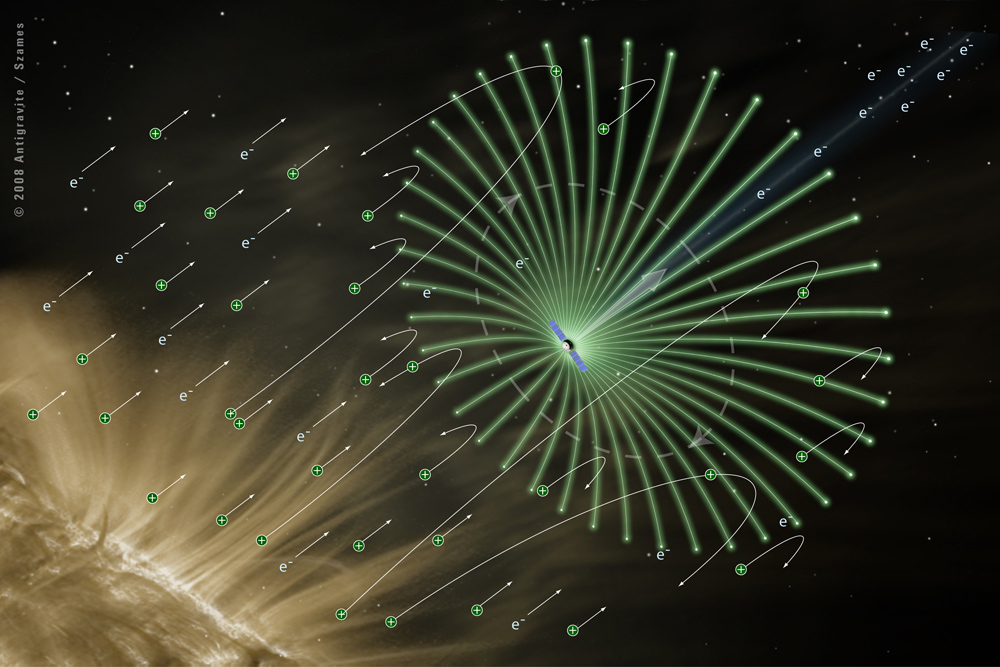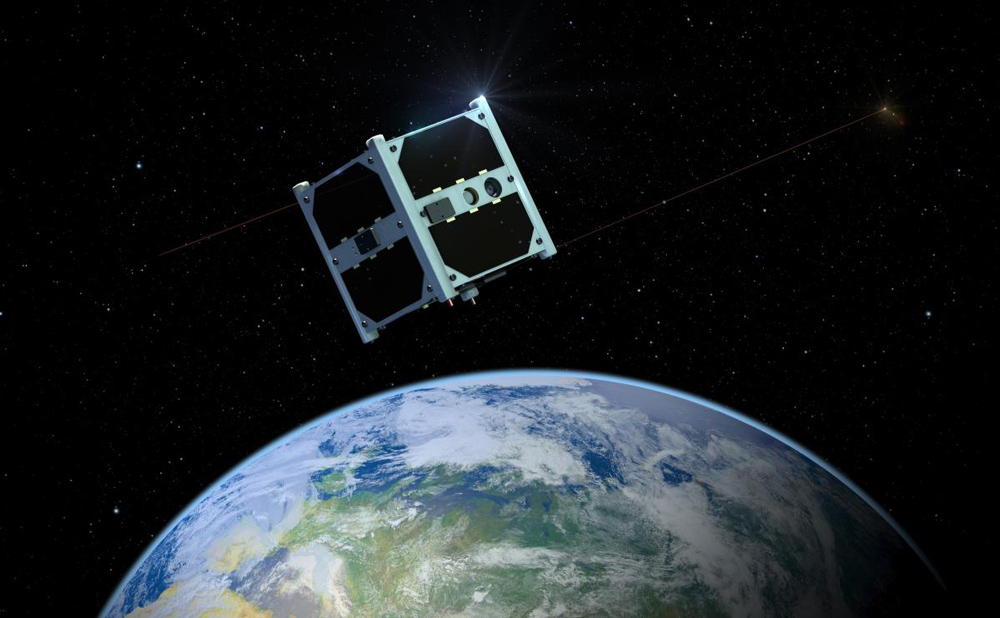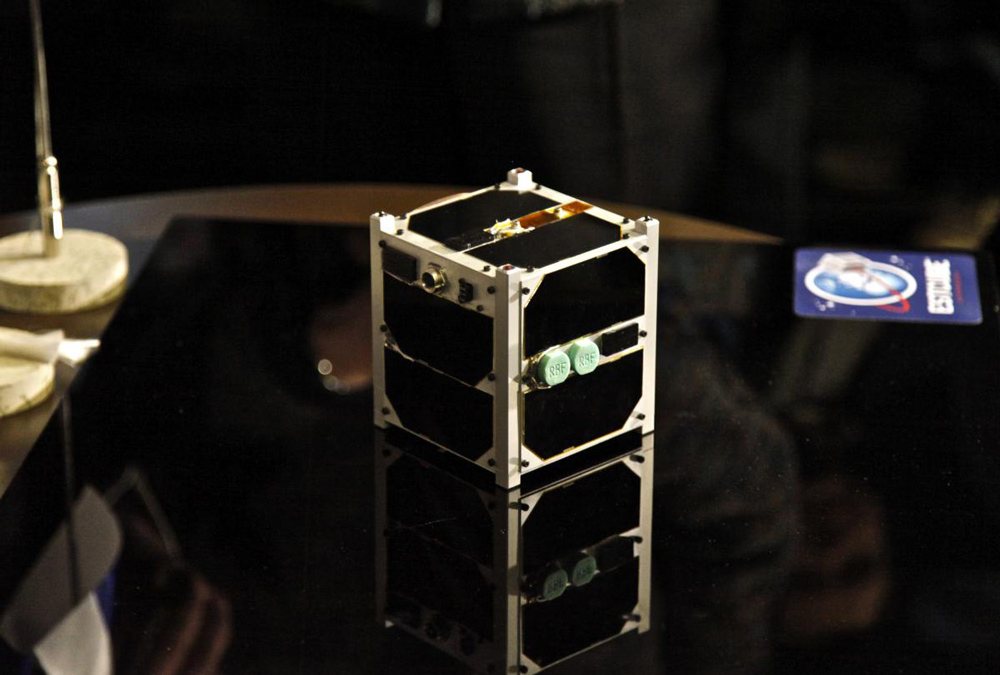ESTCube-1
Estonia is not a very famous space engineering country. But with the student project ESTCube-1 it made a great step towards a space exploring nation. The Cube satellite was sent to orbit to discover the possibilities to use solar wind sail for faster space travelling. It was the first Estonian satellite sent to space in May 7th, 2013. Satellite was built by students from Tartu University, supported by the Estonian Aviation Academy, the Tallinn University of Technology and the University of Life Sciences.
The main mission of the Estonian student satellite was ambitious: to test the electric solar wind sail, a novel space propulsion technology that could revolutionize transportation within the solar system. The solar wind sail was invented by the finnish scientist Pekka Janhunen. This sail uses solar wind momentum for producing thrust. By this «engine with no fuel» it is possible to sail away from the solar system. But not only. By E-sail you can also brake and slow down. This is useful for example for satellites and boosters, who ended their life cycle and need to slow down to burn up in the atmosphere. Usually small mounted rockets tow the old satellites after mission to the atmosphere to destroy space junk, but with a solar sail it should be much easier and cheaper to do. What exactly is a solar wind sail?…and how it is possible to send it to orbit with a cubesat measuring only 10 x 10 x 10 cm and weighing 1.05 kg? It´s amazingly easy. But from other perspective it is as complicated as any other space project with a lot of breaking points, expensive tests and space engineering. But first let´s describe shortly what a solar wind sail or electric sail or e-sail is. A full-scale electric sail consists of a number (50-100) of long (e.g. 20 km), thin (e.g. 25 microns) conducting tethers (nanowires). The spacecraft in the middle contains a solar-powered electron gun (typical power a few hundred watts from solar panels) which is used to keep the spacecraft and the wires in a high (typically 20 kV) positive potential. The electric field of the wires extends a few tens of metres into the surrounding solar wind plasma. Therefore the solar wind ions «see» the wires as rather thick, about 100 m wide obstacles. A technical concept exists for deploying (opening) the wires in a relatively simple way and guiding or «flying» the resulting spacecraft electrically. Wires are moved out from spinning spacecraft and forming a huge «sail». So the finnish scientist Pekka Janhunen describes the invention. Pluto flyby could occur in less than five years using e-sail, for example, and e-sail can tow spacecraft ten times faster than existing technology.
But after all it´s only a theory. All theories need some practical tests, especially space theories. So, Estonian student satellite project took Janhunen´s idea and planned to test it on real environment – in Space. As the e-sail is small and light, it was possible to use a small cubesat satellite for that purpose. For the first experiment a 10 m long tether, which is an integral part of the electric solar wind sail development, was used. Estonian cubesat had the mission to measure the force being excerpted to the sail and to make some pictures of the tether and additionally, if possible, of the Earth and Estonia. Alltogether the Satellite had to do many different tasks: it should communicate, produce electrical power, to correct the orbital attitude, take images with its camera and – the main mission – unreel the tether and charge it electrically. Correcting the orbital attitude was a task for Estonian students which they solve on a unique way: because small cube couldn’t fit any rocket engines to correct the position later, they had to use the magnetic field of the earth. Main parts of ESTCube-1 were:
At the end of 2012 the first Estonian satellite was ready to take off. But for launch, it was still a lot of time to solve different tasks.
Estonian space exploration historyBefore ESTCube-1, there were different instruments on board of seven soviet space missions. But that was before 1991, when Estonia became independent again. Estonia was well known for his «space food» for soviet cosmonauts produced in a small town called Põltsamaa in Central Estonia. But Estonian own space mission started only in 2013. Many durability tests took place before 2013 and electronics standed it successfully. The only problem was that with the nanowires for e-sail. That broke on an overload test (60 times of Earth gravity), one of the heaviest tests, ESTCube had to pass. At the end of January 2013, Estonian students handed the complete set of cubesat nanosatellite over to the European Space Agency. ESTCube-1 travelled to French Guayana to wait for the Ariane rocket launch order. On May 7, 2013, ESTCube-1 launched on board of the Vega VV02 rocket. It was shoot away from POD (special socket for cubesat modules) mechanically, and then ESTCube had to correct his position by the newly invented technology – electromagnetic poles, what used Earth magnetic field to correct the position of small satellites, whereby it is required to determine the attitude with an accuracy better than 2 degrees. Everything went almost as expected. Estonian satellite reached the 670 km height and followed the orbit as expected. After achieving rotational speed of one full turn per second, ESTCube was ready to uncoil a nanowire for experimental measuring of the e-sail charge and thrust it achieved. Unfortunately the distance of 670 km was still too close to earth to get some final statements about the effectiveness of the electric sail, but some first calculations expected to be done according to data sent from ESTCube-1. 50% possibility to failSo, if almost everything went as expected, what went wrong? First, one of four gyroscopic sensors was malfunctioning, but it was not a real problem as three others worked fine. After launch, University of Tartu Scientists expected, that mission will be successful with no more than 50% of trust. The first photo of the Earth had taken on May 15 and transmitted to the ground on the amateur radio band. ESTCube-1 satellite followed some tests what takes two weeks. The orientation of the satellite was set so that the on-board camera turned to earth to acquire images and confirm the orbital attitude of space satellite. Then, a few weeks later, the main mission to deploy the e-sail element from the satellite by centrifugal force was started. The deployment was observed by the on-board camera. When the electron emitter was activated the loading of the E-Sail begun. But unfortunately the plan to test a solar wind sail failed, because the unwinding mechanics did not survive the takeoff vibration of the rocket. The last morse code transmission was transmitted on February 17, 2015, and the satellite board equipment silenced at May 19 this year, after batteries became exhausted and solar panels reached the level when they were unable to support electrical systems of ESTCube-1. Did the space project fail? Not exactlyEvery Estonian taxpayer payed literally about 5 eurocents for that project, but it is still successful despite of e-sail malfunctioning. «For that money, every taxpayer can count on tens of top specialists and engineers in Estonia who have unique experiences to continue with this kind of projects,» said project leader Dr. Mart Noorma from Tartu University. This space program granted 30 bachelor studies, 20 Master´s Thesises and 3 Doctor´s researches to Estonian science. After all, everything they learned can be transferred to ground Earth and use for engineering and science. Satellite camera sent some good quality images down to Earth and it was used for educational purposes in Estonian schools. Because Estonia is an associated member of ESA, most of the launch expenses (about 70’000 euros) were covered by the Estonian member fee. With the launch, total expenses of the project were about 100’000 euros. Finnish satellite Aalto-1 will follow the Estonian mission to space with e-sail. Finnish cubesat will use a 300 m long nanowire and will do experiments at higher altitudes. Then, few years later, the third mission will probably start to unwind 3 km long nanowire at a distance of more than 100’000 km from Earth to test solar wind force away from Earth´s ions influence.
14.10.2015 | Autor
Kaido Einama
-> Drucken
|
MEHR ZU DIESEM THEMA
TOP ARTIKEL
TOP AKTUELLsoeben aufgeschaltet
MEIST GELESEN
|
||||||||||||||||||||||||||||||||||||||||||||||||||
|
|
|||||||||||||||||||||||||||||||||||||||||||||||||||
|
|
|||||||||||||||||||||||||||||||||||||||||||||||||||







